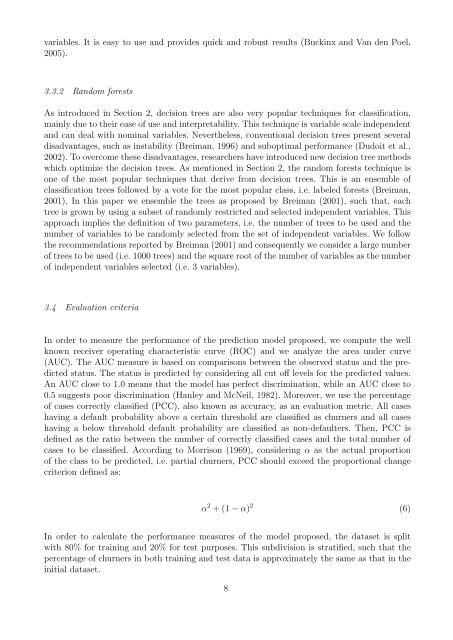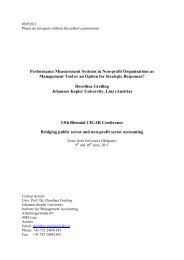Predicting Partial Customer Churn Using Markov for Discrimination ...
Predicting Partial Customer Churn Using Markov for Discrimination ...
Predicting Partial Customer Churn Using Markov for Discrimination ...
You also want an ePaper? Increase the reach of your titles
YUMPU automatically turns print PDFs into web optimized ePapers that Google loves.
variables. It is easy to use and provides quick and robust results (Buckinx and Van den Poel,<br />
2005).<br />
3.3.2 Random <strong>for</strong>ests<br />
As introduced in Section 2, decision trees are also very popular techniques <strong>for</strong> classification,<br />
mainly due to their ease of use and interpretability. This technique is variable scale independent<br />
and can deal with nominal variables. Nevertheless, conventional decision trees present several<br />
disadvantages, such as instability (Breiman, 1996) and suboptimal per<strong>for</strong>mance (Dudoit et al.,<br />
2002). To overcome these disadvantages, researchers have introduced new decision tree methods<br />
which optimize the decision trees. As mentioned in Section 2, the random <strong>for</strong>ests technique is<br />
one of the most popular techniques that derive from decision trees. This is an ensemble of<br />
classification trees followed by a vote <strong>for</strong> the most popular class, i.e. labeled <strong>for</strong>ests (Breiman,<br />
2001). In this paper we ensemble the trees as proposed by Breiman (2001), such that, each<br />
tree is grown by using a subset of randomly restricted and selected independent variables. This<br />
approach implies the definition of two parameters, i.e. the number of trees to be used and the<br />
number of variables to be randomly selected from the set of independent variables. We follow<br />
the recommendations reported by Breiman (2001) and consequently we consider a large number<br />
of trees to be used (i.e. 1000 trees) and the square root of the number of variables as the number<br />
of independent variables selected (i.e. 3 variables).<br />
3.4 Evaluation criteria<br />
In order to measure the per<strong>for</strong>mance of the prediction model proposed, we compute the well<br />
known receiver operating characteristic curve (ROC) and we analyze the area under curve<br />
(AUC). The AUC measure is based on comparisons between the observed status and the predicted<br />
status. The status is predicted by considering all cut off levels <strong>for</strong> the predicted values.<br />
An AUC close to 1.0 means that the model has perfect discrimination, while an AUC close to<br />
0.5 suggests poor discrimination (Hanley and McNeil, 1982). Moreover, we use the percentage<br />
of cases correctly classified (PCC), also known as accuracy, as an evaluation metric. All cases<br />
having a default probability above a certain threshold are classified as churners and all cases<br />
having a below threshold default probability are classified as non-defaulters. Then, PCC is<br />
defined as the ratio between the number of correctly classified cases and the total number of<br />
cases to be classified. According to Morrison (1969), considering α as the actual proportion<br />
of the class to be predicted, i.e. partial churners, PCC should exceed the proportional change<br />
criterion defined as:<br />
α 2 + (1 − α) 2<br />
In order to calculate the per<strong>for</strong>mance measures of the model proposed, the dataset is split<br />
with 80% <strong>for</strong> training and 20% <strong>for</strong> test purposes. This subdivision is stratified, such that the<br />
percentage of churners in both training and test data is approximately the same as that in the<br />
initial dataset.<br />
8<br />
(6)
















